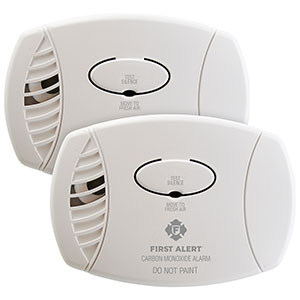Battery Operated Travel Carbon Monoxide Alarm
Battery Operated Travel Carbon Monoxide Alarm
Protect yourself while you travel with this battery operated First Alert Carbon Monoxide Travel Alarm. One button tests all alarm functions as well as mutes unwanted alarms. This carbon monoxide alarm utilizes an electrochemical sensor for increased accuracy. Has easy access to the battery and a durable/lightweight design for optimal portability. 9V battery and travel pouch included. 5-year limited warranty. Carbon Monoxide alarm meets UL standards.
This Carbon Monoxide Alarm is for you if:You want basic protection from the threat of carbon monoxide while you travel.
Where To Place Carbon Monoxide Alarms:
One on every level of the home and one in each sleeping area.
First Alert Battery Operated Travel Carbon Monoxide Alarm CO250T
Here are a few situations that may cause a carbon monoxide alarm "false alarm:"
- The carbon monoxide alarm needs to be relocated. Carbon monoxide alarms should be located 15-20 feet away from all fossil fuel burning sources like furnaces and stoves. Alarms should be located 10 feet away from sources of humidity like showers.
- Fossil fuel burning appliances may not be burning fuel completely. Check pilot lights/flames for blue color. Appearance of yellow or orange flames indicates incomplete combustion-a source of carbon monoxide.
First Alert Battery Operated Travel Carbon Monoxide Alarm Features:
- Battery operated, 1 9V battery included.
- Single button tests alarm function and mutes unwanted alarms.
- EZ access battery door.
- Low battery signal.
- Electrochemical sensor, most accurate technology available for detecting carbon monoxide, compared to other common sensing technologies.
- Loud 85db alarm.
- Meets UL2034 standard.
- Travel pouch, mounting hardware (if desired) and 9V battery included.
- 5-year limited warranty, carbon monoxide alarms should be replaced every 5 years for maximum protection.
- Emits T3 Pattern.
If you are interested in ordering a large quantity of items you may qualify for volume pricing discounts. Volume Discount Pricing is a great way for customers to save big on large, bulk orders of most items available in our store. Please send a bulk order request to our friendly sales staff so they may create a quote and provide personal service for your order! You will receive a response within 1-2 business days and our office hours are Monday through Friday, 8am-5pm CST.
- Let us know what products & the quantities you are interested in.
- Get a detailed quote from a dedicated sales rep.
- Our warehouse ships directly to you.
- You enjoy the savings & are now a preferred customer.

First Alert Battery Operated Travel Carbon Monoxide Alarm - CO250T Reviews
This travel CO detector is great. Small and lightweight for travel needs!
This is very useful, I recommend it.
Recent stories about people being hurt or killed by carbon monoxide in hotel rooms that did not have CO alarms prompted me to look for a travel CO alarm. The First Alert travel CO alarm is perfect. Its small size makes it easy to take on trips, and the reliability of First Alert gives me peace of mind. My home is protected by First Alert Smoke/CO alarms, so why wouldnt I trust them to keep me safe while Im on the road.
I have First Alert carbon monoxide alarms in the recommended places in our house. However, I was surprised to learn that hotels are not required to have CO detectors in rooms. After media reports of 3 fatalities in the same NC hotel room in 2 months prompted me to purchase the F.A. battery powered CO detector for out of town stays. The detector alarm is quite loud and will wake you out of a sound sleep. I do recommend removing the battery if transporting it inside luggage otherwise pressure on the test button may delay you clearing TSA screening. Otherwise, its a great product that everyone should have. Think about it this Christmas, you could give a gift that might save a familys life.















